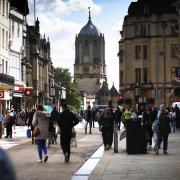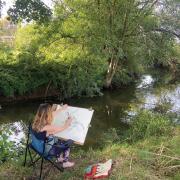This walk is one I do often from my home in Stroud, noting not the folklore but the changing seasons in the wild and feral flowers I see. It’s not an area with abundant tales and folklore, but in the plants themselves we find abundant folk remedies and lore to focus our attention along the way. I’ve based the flowers on some of those I saw on my flower count for this route on May Day last year. You will find plenty more. Last year, I counted 46 flower species blooming on this route – by June it will have rocketed to at least a 100.
The walk starts at Merrywalks in Stroud. As is traditional in a Stroud walk, we’re heading up hill. Go up the snicket before the traffic light on Beeches Green, then go along Loveday’s Mead to the footpath up the hill at the end. Twist through the little copse at the top onto the path through to Oakbrook Farm. Your path will be full of buttercups – did you love butter when the flower was placed under your chin as a child? Did you know that once buttercups were a miser’s gold coins? He refused to share them with the fairies, and so they changed to golden, but worthless and poisonous, flowers instead. However, farmers in the South West got their own back by rubbing buttercup juice onto the udders of their cows to stop the fairies from stealing the milk!

A trio of speedwell, groundsel and shepherd’s purse can be seen by the discerning eye in the farm – speedwell often grows on paths, a cheering sight to speed you along. Turn right out of the farm onto the Old Painswick Road, going past the hawthorn blossom just coming out. Nowadays we don’t pick wildflowers, but it’s considered unlucky to bring the May inside in case you bring sickness or death in with it. But why? Probably because it has a fetid smell, and was said to have reminded people in earlier times about the plague!

Turn into the entrance to Hawkwood College and walk up the drive. Cowslips dot the meadow, famous for the wine you can make from them, and some say it will cure jaundice! Good excuse? Head round past the car park and then, just past a workshop, turn left into the wood and head to the right along the bottom path. The wood will be awash with garlic. The smell hits you first, then the sea of white flowers. It’s said that Odysseus used garlic to stop the sorceress Circe from turning him into a pig, and eating a little of this will keep vampires at bay, of course, but it won’t repel bears! Not that you’re likely to encounter a bear in Hawkwood, but people used to say that bears would eat wild garlic to build up their strength after a long winter’s hibernation. Hawkwood isn’t a bluebell wood, but you may see the deep blue flowers dotted here and there. It’s a far sweeter smell, but beware, if you consume a tincture of bluebell juice it may enable you to see the fairies. Or maybe you’d quite like that?
Head diagonally up to the right through the wood, going up past the meditation cabin onto the wide path that leads to the top right corner of the wood. From there turn right onto the track, where there’ll still be some dog’s mercury blooming, a shy green plant that was named after the Roman god of healing. I’m afraid our British version is poisonous rather than good. Cross over the stile and head up the field. Here you’ll see more tree flowers, fluffy ash and drooping sycamore, as well as more of the May. But what if you see the oak leaves out before the ash? ‘If the oak is out before the ash, then we’ll surely have splash’ says the rhyme. There’s a second line that sums up the British spring: ‘If the ash is out before the oak, then we’re sure to get a soak!’ If you see beech leaves and it is actually May Day, why not make a posy of them for a friend? It’s good luck in this part of Gloucestershire – but only on that one day.

As you head into the top field there’s a larch tree, its incipient cones bright pink in May. The larch is said to guard against evil spirits. Turn around to catch a view of the hills still just visible before the trees put on all their greenery, then proceed straight ahead along the field boundary. Look for ground ivy just coming out along the edges of the field. In herb lore this plant is said to be good for curing styes, and also soothes nettle stings. Because it’s a plant of overgrown, unkempt places it’s regarded with some suspicion as it was thought that witches used it in their spells.

Go through the gate. You’ll see a wonderful view of Swift’s Hill across the Slad Valley. We’re following the valley back to Stroud along Folly Lane. Keep your eyes peeled for the entrance, to the right, into Folly Wood. This wood will give us a completely different wash of white to the garlic in Hawkwood, with sweet woodruff and sanicle gracing the way. If we were in Germany, we might be eating the sweetly-scented woodruff – used, in the past, to flavour jellies and sweets. In Britain it was used as a bedstraw, gathered to stuff mattresses and to strew on the floor. Speaking of beds, woodruff may have been scared to the Norse goddess of love, Freya. Its mildly intoxicating nature also may have spurred soldiers into thinking they were invincible – they wore in in the helmets! Sanicle, on the other hand, was thought a wonder herb, a German proverb saying, ‘he who has sanicle and selfheal needs neither physician nor surgeon.’ Its very name comes from the Latin ‘sanus’ or healthy.
Coming out of the wood, we continue down Folly Lane. Just before you reach the houses, take the path to the right into our last field. By June, this field will be thick with orchids and other meadow flowers. Today, among the buttercups and hawkweeds, if you look very closely, you might find the very first tiny white flowers of fairy flax. If we use ordinary flax to make linen, so the fairies use this miniature version to weave their clothes. Wearing a garland of fairy flax is said to bring good luck, but this is a puzzler as it’s bad luck to pick it!

Go over the stile at the bottom of the field, take the track to the left past the allotments, then cross and walk down the road. When you come to a sharp left turn onto Upper Springfield Road, follow it round then turn right onto Middle Street. Last year in May down this sheltered little street I saw my first poppy of the year, an orange Welsh poppy. Just like the flax, this native poppy is associated with the fairies. They’ll curse you if you pick it, and you’ll tempt storms and lightning strikes if you take the flowers into your house. You’ll have to come back later in the year to this kind of poppy as the seeds provide protection from fairy enchantment. Scatter them around your home, and carry them in your pocket to protect yourself from confusion and memory loss. Another thing to remember in the morning! Keys, phone, poppy seeds?
From Middle Street turn left, then right through Park Gardens. Careful wildflower and bulb planting have made this, my nearest little park, a haven of flowers from January onwards. In May, what I call Queen Anne’s Lace (you may know it as cow parsley) should be just starting to froth out its lacey white flowers. You’ll emerge onto Slad Road, ready to head back into town with your head full of blossom. See what else you can spot in the cracks in the walls and pavements as you go. Flowers get in everywhere.

ESSENTIALS
Distance: 3.5 miles
Duration: 2 hours, if you look closely at the flowers.
Level: Some up and downs, can be a little muddy in the farm and woods.
Parking: Car parks in Stroud.
Toilets and refreshments: Star Anise Arts Café, Stroud (and more places in the town)
Transport links: Merrywalks is Stroud’s bus station; all buses to the town come here, and the railway station is only five minutes away.
LINKS
Route: gb.mapometer.com/walking/route_5511392
Plant lore: plant-lore.com
Hawkwood College: hawkwoodcollege.co.uk
Kirsty Hartsiotis is based in Stroud and available for hire as a storyteller and speaker. She is an Accredited Arts Society lecturer, speaking on art history and folklore. Her books include Wiltshire Folk Tales and (with Anthony Nanson) Gloucestershire Ghost Tales and Gloucestershire Folk Tales for Children. She is also a curator for Swindon Museums.



























